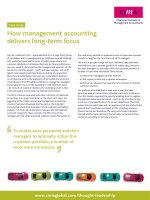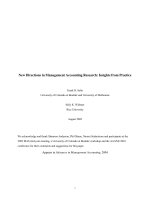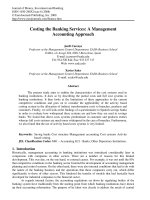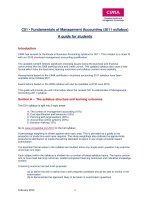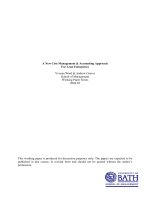FIA passcards FIA FMA management accounting
Bạn đang xem bản rút gọn của tài liệu. Xem và tải ngay bản đầy đủ của tài liệu tại đây (3.48 MB, 209 trang )
ACCA APPROVED
CONTENT PROVIDER
FIA Passcards
FIA FMA / ACCA Paper F2
Management Accounting
Passcards for exams from
1 September 2015 – 31 August 2016
FI33PC15.indd 1
23/03/2015 12:38
(000)FI33PC15_FP_Ricoh.qxp
3/13/2015
6:29 AM
Page i
FIA FMA
ACCA Paper F2
Management Accounting
(000)FI33PC15_FP_Ricoh.qxp
3/13/2015
6:29 AM
First edition 2011, Fourth edition April 2015
ISBN 9781 4727 3544 7
eISBN 9781 4727 2877 7
British Library Cataloguing-in-Publication Data
A catalogue record for this book is available from the
British Library
Published by
BPP Learning Media Ltd
BPP House, Aldine Place
142-144 Uxbridge Road
London W12 8AA
www.bpp.com/learningmedia
Page ii
All rights reserved. No part of this publication may be
reproduced, stored in a retrieval system or transmitted,
in any form or by any means, electronic, mechanical,
photocopying, recording or otherwise, without the prior
written permission of BPP Learning Media.
Printed in the United Kingdom by
RICOH UK Limited
Unit 2
Wells Place
Merstham RH1 3LG
Your learning materials, published by BPP Learning
Media Ltd, are printed on paper obtained from traceable
sustainable sources.
©
BPP Learning Media Ltd
2015
(000)FI33PC15_FP_Ricoh.qxp
3/13/2015
6:29 AM
Page iii
Preface
Contents
Welcome to BPP Learning Media's FIA FMA/ACCA F2 Passcards.
They save you time. Important topics are summarised for you.
They incorporate diagrams to kick start your memory.
They follow the overall structure of the BPP Learning Media Interactive Texts, but BPP's Passcards are not
just a condensed book. Each card has been separately designed for clear presentation. Topics are self
contained and can be grasped visually.
Passcards are still just the right size for pockets, briefcases and bags.
Passcards focus on the exam you will be facing.
Run through the Passcards as often as you can during your final revision period. The day before the exam, try
to go through the Passcards again! You will then be well on your way to passing your exams.
Good luck!
Page iii
(000)FI33PC15_FP_Ricoh.qxp
3/13/2015
6:29 AM
Page iv
Preface
1
2
3
4
5
6
7
8
Accounting for management
Sources of data
Cost classification
Cost behaviour
Presenting information
Accounting for materials
Accounting for labour
Accounting for overheads
9
10
11
12
Absorption and marginal costing
Job, batch and service costing
Process costing
Process costing, joint products and
by-products
Page
1
7
15
23
31
37
47
53
61
67
73
85
Contents
13
14
15
16
17
18
19
20
Alternative costing principles
Forecasting
Budgeting
The budgetary process
Making budgets work
Capital expenditure budgeting
Methods of project appraisal
Standard costing
21
22
Cost variances
Sales variances and operating
statements
Performance measurement
Applications of performance measures
23
24
Page
89
97
111
119
129
135
137
149
153
163
169
183
(001)FI33PC15_CH01.qxp
3/13/2015
1:31 AM
Page 1
1: Accounting for management
Topic List
Planning, control and decision making
Financial and management accounting
Information and decision-making
Data is the raw material for data processing. Information
is data that has been processed in such a way as to
make it meaningful to its user. Management information
is the information used by management to run an
organisation. Some qualities of good information are as
follows.
Relevance
Clarity
Completeness
Accuracy
Timeliness
Manageable in volume
(001)FI33PC15_CH01.qxp
3/13/2015
1:31 AM
Page 2
Planning, control
and decision making
Financial and
management accounting
Information and
decision-making
Information is most likely to be used for planning, control or decision making in management accounting.
Planning involves
Establishing objectives
Selecting appropriate
strategies
Maximise profits
Maximise shareholder
value
Minimise costs
Maximise revenue
Increase market share
Management is decision taking. Management at all
levels within an organisation take decisions. Decision
making involves a choice between alternatives.
Control
An established organisation should have a
system of management reporting that produces
control information in a specific format at
regular intervals.
Effective control is not practical without
planning. Planning without control is pointless.
Basic elements
Management control system
is a system which measures and corrects the performance of
subordinates to ensure organisation's objectives/plans are being met.
Planning
Recording
Carry out plan
Comparing
Evaluating
Corrective action
(001)FI33PC15_CH01.qxp
3/13/2015
1:31 AM
Page 3
Strategic planning
Strategic plans set or change objectives of an organisation. Examples include selection of products and
markets, required levels of profitability and acquisition and disposal of major non-current assets.
Tactical planning
Tactical planning is concerned with decisions about the efficient and effective use of an organisation's
resources to achieve the strategic objectives. Examples include planning direct sales resources, advertising
and so on.
Operational planning
Operational planning is the task of ensuring that specific tasks are carried out effectively and efficiently.
Individuals are given tasks which they are expected to achieve.
Page 3
1: Accounting for management
(001)FI33PC15_CH01.qxp
3/13/2015
1:31 AM
Page 4
Planning, control
and decision making
Financial and
management accounting
Information and
decision-making
The data used to prepare financial accounts and management accounts are the same.
The differences between these accounts arise because the data is analysed differently.
Financial accounts
Prepared for external individuals
Show performance of a defined period
Legal requirements for limited companies to
prepare FA
Format of published FA determined by:
– Law
– IASs
– IFRSs
FA cover business as a whole
FA information monetary (mostly)
Historic picture of past operations
Management accounts
Prepared for internal managers of an organisation
Aid management in recording, planning and
controlling organisation's activities
Help decision-making process
No legal requirements to prepare MA
Format of MA at discretion of management
MA can focus on specific areas of an
organisation's activities
MA incorporate non-monetary measures
Historic record and future planning tool
(001)FI33PC15_CH01.qxp
3/13/2015
1:31 AM
Page 5
Planning, control
and decision making
Financial and
management accounting
Information and
decision-making
Cost accounting information has limited use for decision-making.
Decision making is concerned with
the future so there will always be
some degree of uncertainty
Information for decision making
should therefore incorporate
uncertainty
However, even information which incorporates uncertainty, can never be risk free.
Page 5
1: Accounting for management
(001)FI33PC15_CH01.qxp
3/13/2015
1:31 AM
Page 6
Notes
(002)FI33PC15_CH02.qxp
3/13/2015
1:36 AM
Page 7
2: Sources of data
Topic List
Data and information
Types and sources of data
Sampling
This chapter considers the ways in which data useful to
the accountant can be collected.
You need to be aware of the way in which the various
types of sample are determined and you need a good
grasp of the benefits and limitations of the various
sampling methods.
In terms of sources of data, you need an awareness of
their strengths and limitations.
(002)FI33PC15_CH02.qxp
3/13/2015
1:36 AM
Page 8
Types and sources
of data
Data and
information
Data
... is the raw material for data processing.
Quantitative data
Data that can be measured.
Temperature, degrees Fahrenheit or Celsius
Time it takes to swim 50 lengths, hours or minutes
Qualitative data
Data that have attributes which cannot be measured.
An example is whether one is male or female.
Sampling
Information
... is data that has been processed in such a way as to
make it meaningful to its user.
Some qualities of good information
are as follows
Relevance
Timeliness
Manageable in volume
Accuracy
Completeness
Clarity
Quantitative information
... is capable of being expressed in numbers. It may be
financial in nature eg. profit before tax is $5 million.
Qualitative information
... may not be expressed easily in terms of numbers, but
more likely to reflect the quality of something eg.
competition was fierce.
(002)FI33PC15_CH02.qxp
3/13/2015
1:36 AM
Page 9
Data and
information
Types and sources
of data
Sampling
Types of data
Sample and population data
In addition to being either quantitative or qualitative
data may be further classified as:
Sample data are data arising as a result of investigating a
sample. A sample is a selection from the population.
Primary and secondary data
Population data are data arising as a result of investigating
the population. A population is the group of people or
objects of interest to a data collector.
Primary data are data collected especially for a specific
purpose. Raw data are primary data which have not
been processed at all, and which are still just a list of
numbers.
The diagram below should help you to remember the ways in
which data may be classified.
Secondary data are data which have already been
collected elsewhere, for some other purpose, but which
can be used or adapted for the survey being conducted.
QUANTITATIVE
QUALITATIVE
(variables that can be measured)
(attributes that cannot
be measured)
Discrete and continuous data
Discrete data are data that can only be taken on a finite
or countable number of values within a given range.
Continuous data are data which can take on any value.
They are measured rather than counted.
Page 9
DATA
DISCRETE CONTINUOUS
(countable
number)
(any value)
PRIMARY SECONDARY
PRIMARY OR SECONDARY
2: Sources of data
(002)FI33PC15_CH02.qxp
3/13/2015
1:36 AM
Page 10
Data and
information
Primary external
sources: surveys
Types and sources
of data
Postal questionnaires
Interviews
Interview types
Personal interviews
Store/shopping mall intercept surveys
Focus groups
Telephone interviews
Sampling
Primary external data is often
used to draw up the 'standard'
within a control system.
Customer survey data may
provide the basis for sales
targets, for example.
Source
Advantages
Disadvantages
Personal interviews
Higher response rate and more accurate
responses
Time consuming and expensive
Focus groups
Inexpensive and quick
Dependent on interviewer skill and can be
inhibiting
Telephone interviews
Quick, cheap and wide coverage
Bias and high refusal rates
Postal questionnaires
Relatively cheap and interviewer cannot
influence participants
High refusal rates and misunderstanding
(002)FI33PC15_CH02.qxp
3/13/2015
1:36 AM
Page 11
Secondary external sources
Limitations
Examples
User will be unaware of limitations in the data
Data may not be suitable for its intended use
Data may be out of date
Geographical area covered may not be appropriate
Governments
Trade journals
Newspapers
Internet
Banks
Internal sources
Standard costing, budgeting and performance measurement control systems need to record a wide range of
internal data such as the quantity of material used, prices paid and hours worked.
Page 11
2: Sources of data
(002)FI33PC15_CH02.qxp
3/13/2015
1:36 AM
Page 12
Data and
information
Types and sources
of data
Sampling
If all members of a population are examined, the survey is called a census. If it is not possible to survey the
entire population, a sample is selected. The results from the sample are used to estimate the results of the
whole population.
Random sample
Sampling frame
Selected in such a way that every item in the
population has an equal chance of being included
If random sampling is used, a sampling frame
has to be constructed.
Drawbacks
Might be expensive
Can produce an unrepresentative sample
Sampling frame might not exist
A numbered list of all items in a
population
Once such a list has been prepared, a
random sample can be selected using
random number tables.
If random sampling is too expensive,
quasi-random sampling can be used.
If a sampling frame does not exist, nonrandom sampling must be used.
(002)FI33PC15_CH02.qxp
3/13/2015
1:36 AM
Page 13
Quasi-random sampling
Provides a good approximation to random sampling but requires the existence of a sampling frame
Systematic sampling involves
selecting every nth item after a
random start.
Features
Easy to use
Reasonably random
Biased sample might be
chosen if the population
has a regular pattern
coinciding with the
sampling interval
Page 13
Stratified sampling involves dividing
the population into categories from
which random samples are taken.
Features
Representative sample selected
Sample structure reflects that of
the population
Inferences can be made about
each category
Requires prior knowledge of
each population item
Multistage sampling involves
dividing the population into subpopulations from which a small
random sample is selected.
Features
Does not require a sampling
frame of the entire population
Relatively cheap
Not truly random
Possibility of bias
2: Sources of data
(002)FI33PC15_CH02.qxp
3/13/2015
1:36 AM
Page 14
Data and
information
Types and sources
of data
Sampling
Non-random sampling
Used when a sampling frame cannot be established
Quota sampling is commonly used by market researchers
and involves stratifying the population and restricting the
sample to a fixed number in each stratum.
Cluster sampling involves selecting one definable
subsection of the population as the sample, that subsection
taken to be representative of the population in question.
Features
Features
Cheap and administratively easy
Inexpensive to operate
Much larger samples can be studied
Good alternative to multistage sampling if a sampling
frame does not exist
No sampling frame required
Can yield accurate enough information for many
forms of commercial market research
May result in certain bias
Potential for considerable bias
(003)FI33PC15_CH03.qxp
3/13/2015
2:25 AM
Page 15
3: Cost classification
Topic List
Direct costs and indirect costs
Fixed costs and variable costs
Other cost classifications
Responsibility centres and cost units
The classification of costs is an essential management
accounting technique. Its main uses are as follows:
Determination of the cost of a unit of product or service
Cost behaviour
Absorption and marginal costing
Once costs have been classified, a coding system can be
applied to make it easier to manage cost data.
(003)FI33PC15_CH03.qxp
3/13/2015
2:25 AM
Direct costs and
indirect costs
Page 16
Fixed costs and
variable costs
Other cost
classifications
Responsibility centres
and cost units
Direct cost
Indirect cost (overhead)
... is a cost that can be traced in full to the
product, service or department that is being
costed.
... is a cost that is incurred whilst making a
product but which cannot be traced
directly to the product, service or
department.
Direct costs include
Direct materials
+
Direct labour
Direct expenses
Total direct costs = prime cost
Total product cost
Indirect costs include
Indirect materials
Indirect labour
Indirect expenses
Administration overhead
Selling and distribution overhead
(003)FI33PC15_CH03.qxp
3/13/2015
2:25 AM
Direct costs and
indirect costs
Fixed cost
Page 17
Other cost
classifications
Fixed costs and
variable costs
Variable cost
... is a cost which is unaffected by changes
in the level of activity.
Fixed costs include
Rent of a building
Business rates
Salary of a director
Page 17
Responsibility centres
and cost units
... is a cost which tends to vary with the
level of activity.
Costs may also be
semi-fixed or semivariable or mixed
costs. For example, an
electricity bill has a
fixed standing charge
and a variable cost
per unit of electricity
used.
Variable costs include
Direct materials
Direct labour
Sales commission (varies with
volume of sales)
3: Cost classification
(003)FI33PC15_CH03.qxp
3/13/2015
2:25 AM
Direct costs and
indirect costs
Functional costs
Page 18
Fixed costs and
variable costs
Other cost
classifications
Product/Production costs
Responsibility centres
and cost units
Period costs
... are classified as: production or
manufacturing costs;
administration costs; marketing or
selling and distribution costs.
... are costs identified with a finished
product and are part of the inventory
value until they are sold when they
become expenses (cost of goods sold).
... are costs that are deducted
as expenses during a period
without ever being part of the
inventory value.
Discretionary costs
Avoidable costs
Unavoidable costs
... are costs which are likely to
arise from decisions made
during the budgeting process.
... are costs specific to an activity or
business which would be avoided if
the activity or business did not exist.
... are costs which would be
incurred whether or not the
activity or business existed.
Controllable cost
Uncontrollable cost
... is a cost which can be influenced by
management decisions and actions.
... is any cost that cannot be affected by
management within a given time span.
(003)FI33PC15_CH03.qxp
3/13/2015
2:25 AM
Page 19
Production costs (product costs)
... are costs identified with goods produced for resale
Used to value inventory and output
Non production costs
... are costs deducted as expenses during the period
such as administration, selling, distribution and finance
Not included in inventory valuation and output
Examples
Administration – eg management, secretarial and accounting costs
Selling and distribution – eg advertising, delivery costs, sales staff salaries
Finance – eg cost of raising money to finance business such as a loan or overdraft
Page 19
3: Cost classification
(003)FI33PC15_CH03.qxp
3/13/2015
2:25 AM
Direct costs and
indirect costs
Page 20
Fixed costs and
variable costs
Other cost
classifications
Responsibility
centres and cost units
A responsibility centre is a department or organisational function whose performance is the direct responsibility
of a specific manager.
Cost centre
Revenue centre
... is a collecting place for costs before they
are analysed further.
Cost centre managers are
responsible for costs only
Profit centre
Similar to a cost centre
Responsible for costs and revenues
... is a collecting place for revenues before
they are analysed further.
Revenue centre managers are
responsible for revenues only
Investment centre
Profit centre with additional responsibilities
Responsible for costs and revenues
Responsible for capital investment and
financing

